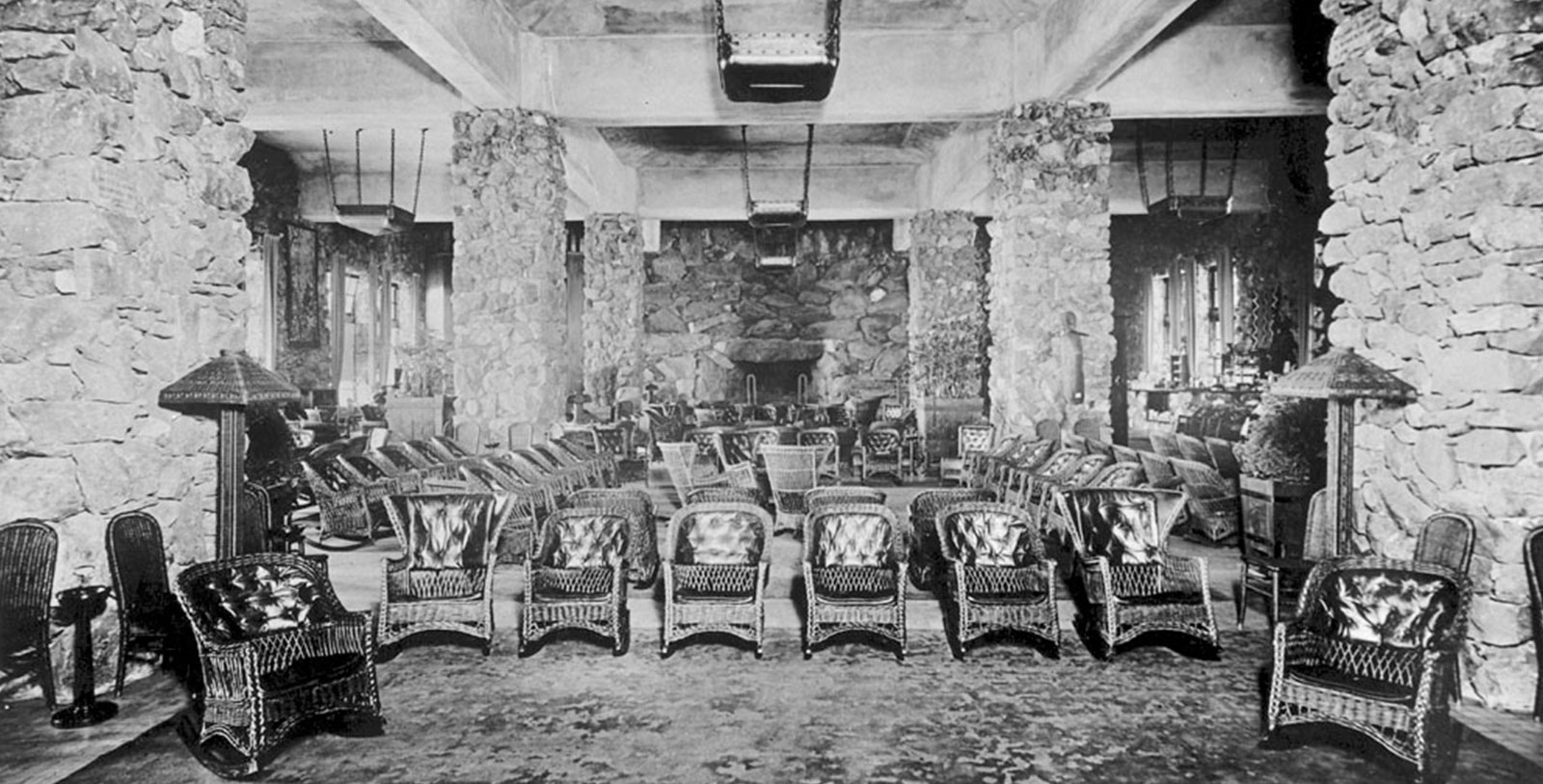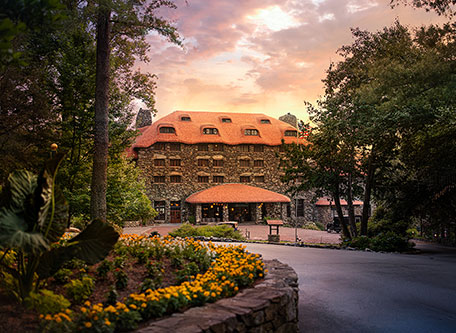Receive for Free - Discover & Explore eNewsletter monthly with advance notice of special offers, packages, and insider savings from 10% - 30% off Best Available Rates at selected hotels.
history
Discover Omni Grove Park Inn, a mountain oasis adorned with distinctive stone architecture and founded by Edwin W. Grove.
Omni Grove Park Inn, a member of Historic Hotels of America since 2000, dates back to 1913.
VIEW TIMELINEThe history of Omni Grove Park Inn traces back to an aspiring pharmacist named Edwin Wiley Grove. Born on a rural farm in the 1850s, Grove pursued a career in pharmaceuticals in order to elevate himself out of severe poverty. The first step in Grove’s grand plan involved purchasing a pharmacy in Paris, Tennessee, where he invested all of his time formulating a tasteless formula that could fight malaria. Grove had created a beverage that he called “Grove’s Tasteless Chill Tonic” after several years of experimentation, which purportedly relieved the symptoms of the disease almost immediately. His tonic became an overnight success, becoming a household name for other contemporary concoctions like Coca-Cola. Grove had even managed to sell 1.5 million bottles of his tonic over the course of two decades, amassing a great fortune in the process. It was around this time that Grove first discovered Asheville. Often ill with bronchitis, Grove’s doctors recommended that he convalesce in the clean mountain air of western North Carolina. As such, he stumbled upon Asheville and quickly fell in love with it.
Despite his poor health, Grove continued to push himself to create bigger and better pharmaceutical inventions. He traveled the nation looking for new business partners, as well as novel sources of inspiration. On one trip to Detroit, Grove encountered a likeminded soul named Fred Seely. The men formed a strong friendship that was to last for years. Grove eventually invited Seely to his summer residence in Asheville, where they decided to work together operating the Paris Medicine Company. Grove and Seely nonetheless started to see that another economic opportunity awaited them in Asheville itself. The two realized that the tranquil environs of Asheville provided the perfect setting in which to promote the health and wellbeing of the nation’s weary. They quickly began planning for the creation of a grand hotel that would embody those sentiments. In 1909, Grove and Seely purchased some 400 acres of land near Sunset Mountain to serve as the site of their secluded retreat.
Grove and Seely then began to construct their mountainside hotel not long thereafter. But they struggled to find the right architectural layout, having rejected the plans from several prominent architects. Seely eventually resolved the problem by presenting his own sketch of the hotel, which Grove quickly adored. Seely’s own plan called for the use of Arts and Crafts-style architecture in the hope that the structure would properly reflect the rustic culture of the Blue Ridge Mountains. The project proved to be a mammoth undertaking. Some 400 men worked on building, often logging 10-hour per shifts over a six-day work week. The construction crew lugged thousands of pounds of granite up the mountain, with just the use of rudimentary tools like mules and wagons. Nevertheless, Seely, Grove, and their massive team managed to complete the hotel in just under a year. Named “The Grove Park Inn,” the doors swung open for the first time on July 12, 1913. Then Secretary of State, William Jennings Bryan, even gave the keynote address, in which he proclaimed that the destination, “was built for the ages.”
Charles Sammons of the massive real estate conglomerate, Sammons Enterprises, acquired the entire building in 1955. Through Sammons Enterprises, Charles Sammons and his family significantly transformed The Grove Park Inn into a leading international resort. The culmination of their work transpired during the late 1980s, when they added the resort’s renowned multimillion-dollar spa facility. The Sammons eventually sold The Grove Park Inn to KSL Resorts in 2012, which, in turn, sold it to Omni Hotels and Resorts roughly a year later. The company then began an extensive rehabilitation of the entire resort at a cost of $25 million. Omni Hotels and Resort subsequently renamed the location as “The Omni Grove Park Inn.” A member of Historic Hotels of America since 2007, The Omni Grove Park Inn still maintains its status as being one of the most exclusive places in vacation throughout the entire United States.
-
About the Location +
Omni Grove Park Inn is located in the quaint community of Asheville, North Carolina. A town steeped in history, Asheville features over 100 different locations that the U.S. Secretary of the Interior has listed on its National Register of Historic Places. The Omni Grove Park Inn is mere moments away from the Grove Park Historic District—a neighborhood recognized for its immense architectural diversity. Composed of some 290 buildings, the area was once a planned suburban community designed by Chauncey Beadle just prior to the outbreak of World War I. At the time, Beadle was known all over North America for his landscaping talents, having created countless parks and gardens across the southern United States. Most of the historic structures display different varieties of Colonial Revival, Tudor Revival, and Bungalow-style architecture. The Grove Park Inn is also close to many more celebrated historic sites, too, including the Thomas Wolfe Memorial, the Historic Greenwood Village, and the Montford Area Historic District.
Perhaps the greatest of these cultural landmarks is the Biltmore Estate. Constructed by the Vanderbilt family during the 1890s, the destination is a beautiful Gilded-Age mansion that is also the largest privately-owned house in the United States. The project had specifically been commissioned by George Washington Vanderbilt II, who was a prominent railroad and steamboat magnate during the late 19th century. Architect Richard Morris Hunt designed the structure to resemble a gorgeous French chateau, while the great Frederick Law Olmstead landscaped the 8,000 acres that surrounded the mansion. Measuring 178,926 sq. ft., Vanderbilt required a massive workforce to tend to the building. To facilitate such a large body of employees, he constructed the “Biltmore Village,” which had been known at the time as “Best.” The nucleus of this community still exists today, sitting adjacent to the mansion’s main entrance. The Biltmore Estate is now listed on the U.S. National Register of Historic Places and is recognized by the federal government as a National Historic Landmark. Despite its status as a private residence, the mansion is open to tours for the general public.
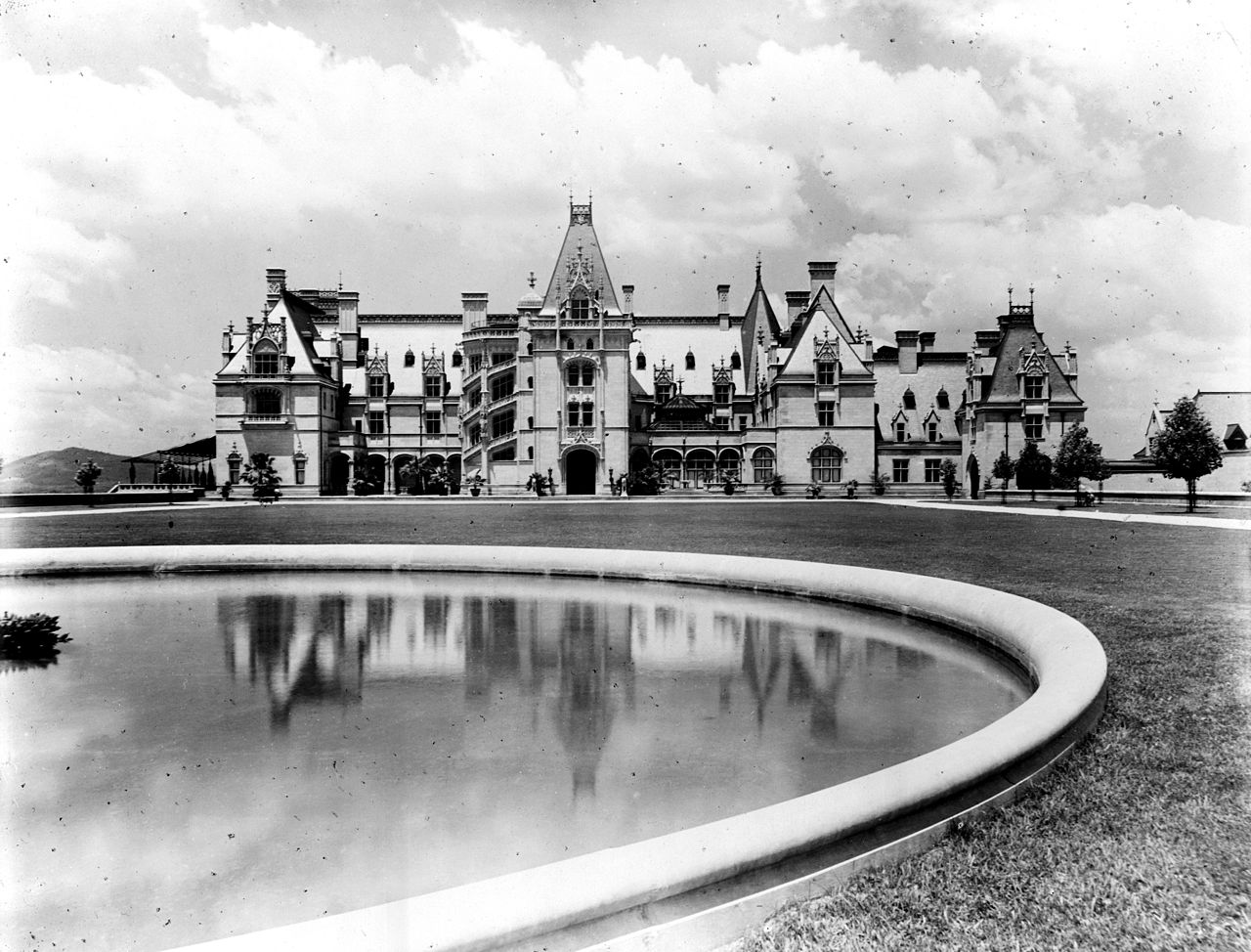
(Historical Image of the Biltmore Estate, Asheville, North Carolina.)
Asheville itself resides at the western edge of North Carolina’s Blue Ridge Mountains, and is just a short drive away from Pisgah National Forest and the Eastern Band of Cherokee Indians. The city dates to a small frontier settlement founded by John Burton during the 1790s. Burton decided to name the community as “Morristown,” in honor of American patriot Robert Morris. But Morristown was renamed “Asheville” after North Carolina’s governor, Samuel Ashe, when the state legislature chartered it in 1797. Asheville gradually became a major center for manufacturing in western North Carolina during the 1800s, in which the arrival of railroads facilitated the growth of factories throughout the community. Textile mills became a common sight in Asheville, as were plants that processed various raw materials. This economic growth slowed considerably due to the Great Depression, when most of the local banks went bankrupt. The silver lining to the calamity was that many of the historic buildings in downtown Asheville remained untouched, leaving the city with one of the largest collections of original Art Deco structures in the entire country. Asheville today has undergone a cultural renaissance and is a favorite destination for travelers eager to explore the surrounding mountainous terrain.
-
About the Architecture +
The construction of The Grove Park Inn proved to be a mammoth undertaking when it first began during the summer of 1912. Four-hundred men were needed to work on the project, who often worked 10-hour shifts over the course of a six-day work week. The construction crew lugged thousands of pounds of granite up Sunset Mountain, as well, with just the use of rudimentary tools like mules and wagons. Inspired by the design aesthetics of the Arts and Crafts movement, Seely’s plan for the building was incredibly meticulous, too. It directed the laborers to construct the hotel around a frame consisting of steel and concrete. Italian stonemasons then began the laborious process of fitting thousands of granite stones into the exterior façade. Steely had specifically instructed that every single stone show its most weather surface in order to give the building a timeless ambiance. He also designed an intricate fireproof roof made from a combination of concrete, asphalt, and red clay tile. The material was so thick that it measured three full feet in width. Despite the great demands of the project, they all miraculously managed to finish the project within the span of a single year.
Seely and his team also applied their careful eye for detail to the hotel’s many interior spaces. The most notable area of work concerned an area known today as the Great Hall. This spectacular room is called the “Great Hall” for good reason, as it measures 120 feet in length. There are also two massive, 14-foot fireplaces, which serve as the centerpiece for the room. Its andirons weight some 500 pounds and were constructed with the same granite stones that constituted the exterior of Omni Grove Park’s exterior façade. The two fireplaces originally functioned as the main source of heating sources during the winter, with the hotel’s staff using several nine-foot-long long for fuel. The lobby—as well as the rest of the resort—were also furnished with the finest décor from the Roycroft Artisan Community. Based out of East Aurora, New York, the craftsmen were among the best in the entire country. They supplied all of the 600 ornate light fixtures installed throughout The Omni Grove Park Inn, as well as the marvelous pieces of oak scattered across the building. The Roycroft Artisan Community also developed a marvelous eight-foot grandfather clock. It had a beautiful, hammered copper face that bore the insignia of the Roycroft Artisan Community on its left side. This elegant clock still resides adjacent to the resort’s main entrance, welcoming guests into The Omni Grove Park Inn in the same way it had over a century ago.
-
Famous Historic Guests +
Harry Houdini, famous illusionist and stunt performer.
Al Jolson, actor and comedian known for starring in the first talking motion picture, The Jazz Singer.
Will Rogers, actor known for his roles in such films like Judge Priest, In Old Kentucky, and Steamboat Round the Bend.
Henry Ford, founder of the Ford Motor Company.
John D. Rockefeller, founder of the Standard Oil Company.
Harvey Firestone, founder of the Firestone Tire and Rubber Company.
Charles Schwab, founder of the Bethlehem Steel Corporation.
Thomas Edison, entrepreneur responsible for such inventions like the motion picture camera and the electric lightbulb.
Albert Einstein, Nobel Prize winning physicist known for his role in developing quantum theory.
Billy Graham, Baptist minister and spiritual advisor to every U.S. President from Harry S. Truman to Barack Obama.
George Masa, Japanese businessman and professional large-format photographer.
Wiley Post, aviator remembered for completing the first solo flight around the world.
F. Scott Fitzgerald, author remember today for writing The Great Gatsby.
Margaret Mitchell, author remember today for writing Gone with the Wind.
Carl Sandburg, Pulitzer Prize-winning author known for his poems and biographical work.
Alex Haley, author remembered today for writing Roots: The Saga of an American Family.
George Gershwin, musician known today for his opera Porgy and Bess, as well as many other productions.
Bobby Jones, Jr., professional golfer who helped found the Masters Tournament and the Augusta National Golf Club.
Jack Nicklaus, winner of 18 major golf championships—the most of any professional golfer.
John J. Pershing, commanding general of the American Expeditionary Force during World War I.
William Jennings Bryan, Secretary of State under President Woodrow Wilson and participant in the Scopes Trial.
Helen Keller, first deaf-blind person in American history to successfully earn a college degree.
Eleanor Roosevelt, First Lady of former U.S. President Franklin Delano Roosevelt (1933 – 1945)
William Howard Taft, 27th President of the United States (1909 – 1913) and 10th Chief Justice of the United States (1921 – 1930)
Woodrow Wilson, 28th President of the United States (1913 – 1921)
Calvin Coolidge, 30th President of the United States (1923 – 1929)
Herbert Hoover, 31st President of the United States (1929 – 1933)
Franklin Delano Roosevelt, 32nd President of the United States (1933 – 1945)
Dwight D. Eisenhower, 34th President of the United States (1953 – 1961), and Supreme Allied Commander Europe during World War II.
Richard Nixon, 37th President of the United States (1969 – 1974)
George H.W. Bush, 41st President of the United States (1989 – 1993)
Bill Clinton, 42nd President of the United States (1993 – 2001)
Barack Obama, 44th President of the United States (2009 – 2017)
-
Women in History +
Helen Keller: Helen Keller was one of the first guests to vacation at The Grove Park Inn—a distinction that the resort is proud to possess. She was the first deaf-blind person in American history to successfully earn a college degree. According to her biographers, Keller had become afflicted with an unknown illness as a toddler, which greatly impacted her sight and hearing. Her family stopped at nothing to get her the best help available, travelling all the way from their native Alabama to meet with eye, ear, and nose physicians in Baltimore. They, in turn, directed the Kellers to inventor Alexander Graham Bell, who had been working with deaf and blind children at the time. Bell informed the Kellers of a school called the Perkins Institute for the Blind in Boston that would provide the best education for Helen during her youth. Helen Keller was then paired with an alumnus of the academy named Anne Sullivan, who would guide the young girl through her lessons. It was the start of a historic relationship that would be immortalized in a series of films known as The Miracle Worker. Sullivan managed to aid Keller in learning how to communicate through sign language, with her first word being “water.” Keller quickly became proficient at reading sign language with her hands, as well as braille. As she got older, Keller enrolled in The Cambridge School for Young Ladies, and then Harvard University’s Radcliffe College. Keller graduated with top honors from Harvard, leaving the school as a member of Phi Beta Kappa. She then went on to establish a career as an author and motivation speaker that was hailed throughout the world. Keller also had an active political career, becoming a champion for such causes as global pacifism and women’s suffrage. She even helped found the American Civil Liberties Union in 1920. Yet, the cause that Keller is best remembered is her tireless campaigning for the rights of Americans who experienced some form of physical disability. Keller has since received numerous accolades for her work toward the end of her life, including the Presidential Medal of Freedom and a place in the National Women’s Hall of Fame.
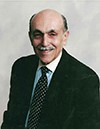
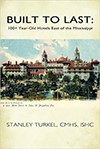
Guest Historian Series
Nobody Asked Me, But... No. 151;
Hotel History: The Omni Grove Park Inn (1913), Asheville, North Carolina*
By Stanley Turkel, CMHS
The Omni Grove Park Inn is a historic resort located in the Blue Ridge Mountains in Asheville, North Carolina. It was built by Edwin Wiley Grove (1850-1927), owner of the Paris Medicine Company, manufacturer of Bromo-Quinine and Tasteless Chill Tonic. When Grove could not find a local architect who grasped his concept, he entrusted the project to his son-in-law Fred Loring Seely, who had no formal training in architecture or the building trades. Nevertheless, Seely designed a magnificent lodge which was built of native uncut granite boulders quarried from Sunset Mountain. The Inn was furnished by the Roycrofters of East Aurora, New York, one of the most important designers and manufacturers of American Arts and Craft furniture, metal work and other accessories. Some 400 rugs were made in France, and linen curtains and spreads were imported from Ireland. To make the building fireproof, Seely designed a three-foot thick roof composed of cement, steel rods, asphalt and red clay tiles.
Construction was completed in 11 months and 27 days by careful planning and paying high wages to dedicated workers who were housed in tents erected on the job site. The golf course at the Grove Park Inn was built in 1899 and redesigned in 1924 by Donald Ross. Now owned by the Grove Park Inn, the par-70 course is a member club open to guests, members and the public.
The Inn was used for some unusual purposes:
- During World War II, it was utilized as an internment center for Axis diplomats
- Later in the war, it was used by the U.S. Navy as a rest and rehabilitation center for returning sailors
- In 1944-45, the Inn was an Army Redistribution Station where soldiers rested before being assigned to other duties
- The Philippine Government operated in exile from the Presidential Cottage on the grounds during the World War II
The Grove Park Inn has attracted many celebrities in the past 100 years including William Jennings Bryan (who spoke at the hotel's opening), Thomas Edison, Henry Ford, Harvey Firestone, Elbert Hubbard, Woodrow Wilson, John D. Rockefeller, General John J. Pershing, Dean Smith, Jerry Seinfeld, David & Amy Sedaris, Sanjay Gupta, Trey Anastasio, William Howard Taft, Franklin D. Roosevelt, Herbert Hoover, Dwight Eisenhower, Enrico Caruso, Harry Houdini, Al Jolson, F. Scott Fitzgerald, Bobby Jones, Wiley Post, Will Rogers, Bill Tilden, Billy Graham, Don Cheadle, Barack Obama, and many others. F. Scott Fitzgerald lived at the Inn for about a year in 1935 and 1936 when he was struggling with tuberculosis and alcoholism.
His wife, Zelda, was institutionalized with schizophrenia in an Asheville hospital. Mementoes of the Grove Park Inn's past are found throughout the public areas. Photographs of former notable guests hang in one corridor and empty bottles of Tasteless Chill Tonic and early menus are on display in glass cases. Also in evidence is the eight-foot-tall clock made by the Roycraft Shop for the Inn. With its hand-hammered face and oversized hardware, the clock may well be one of the most important objects to come out of the Roycraft Shops. The Grove Park Inn provides great activities including horse-drawn carriage rides, an 18-hole golf course, nine tennis courts and a fully equipped sports center as well as a nightclub and eight gift shops. The most appealing guest activities at the Grove Park Inn may be the simplest ones, a meditation before a blazing fire or a post-dinner conversation in a mission rocker on the porch.
From 1955 to 2012, the Inn was owned and operated by Sammons Enterprises until 2012 when KSL Resorts acquired it. The Inn features a 43,000 square-foot modern subterranean spa which recently was ranked #5 in the U.S. by Travel + Leisure.
*excerpted from his book Built To Last: 100+ Year-Old Hotels East of the Mississippi
*****
About Stanley Turkel, CMHS
Stanley Turkel is a recognized consultant in the hotel industry. He operates his hotel consulting practice serving as an expert witness in hotel-related cases and providing asset management an and hotel franchising consultation. Prior to forming his hotel consulting firm, Turkel was the Product Line Manager for worldwide Hotel/Motel Operations at the International Telephone & Telegraph Co. overseeing the Sheraton Corporation of America. Before joining IT&T, he was the Resident Manager of the Americana Hotel (1842 Rooms), General Manager of the Drake Hotel (680 Rooms) and General Manager of the Summit Hotel (762 Rooms), all in New York City. He serves as a Friend of the Tisch Center and lectures at the NYU Tisch Center for Hospitality and Tourism. He is certified as a Master Hotel Supplier Emeritus by the Educational Institute of the American Hotel and Lodging Association. He served for eleven years as Chairman of the Board of the Trustees of the City Club of New York and is now the Honorary Chairman.
Stanley Turkel is one of the most widely-published authors in the hospitality field. More than 275 articles on various hotel subjects have been posted in hotel magazines and on the Hotel-Online, Blue MauMau, Hotel News Resource and eTurboNews websites. Two of his hotel books have been promoted, distributed and sold by the American Hotel & Lodging Educational Institute (Great American Hoteliers: Pioneers of the Hotel Industry and Built To Last: 100+ Year-Old Hotels East of the Mississippi). A third hotel book (Built To Last: 100+ Year-Old Hotels in New York) was called "passionate and informative" by the New York Times. Executive Vice President of Historic Hotels of America, Lawrence Horwitz, has even praised one book, Great American Hoteliers Volume 2: Pioneers of the Hotel Industry:
- “If you have ever been in a hotel, as a guest, attended a conference, enjoyed a romantic dinner, celebrated a special occasion, or worked as a hotelier in the front or back of the house, Great American Hoteliers, Volume 2: Pioneers of the Hotel Industry is a must read book. This book is recommended for any business person, entrepreneur, student, or aspiring hotelier. This book is an excellent history book with insights into seventeen of the great innovators and visionaries of the hotel industry and their inspirational stories.”
Turkel was designated as the “2014 Historian of the Year by Historic Hotels of America,” the official program of the National Trust for Historic Preservation. This award is presented to an individual for making a unique contribution in the research and presentation of history and whose work has encouraged a wide discussion, greater understanding and enthusiasm for American History.
Works published by Stanley Turkel include:
- Heroes of the American Reconstruction (2005)
- Great American Hoteliers: Pioneers of the Hotel Industry (2009)
- Built To Last: 100+ Year-Old Hotels in New York (2011)
- Built To Last: 100+ Year-Old Hotels East of the Mississippi (2013)
- Hotel Mavens: Lucius M. Boomer, George C. Boldt and Oscar of the Waldorf (2014)
- Great American Hoteliers Volume 2: Pioneers of the Hotel Industry (2016)
- Built To Last: 100+ Year-Old Hotels West of the Mississippi (2017)
- Hotel Mavens Volume 2: Henry Morrison Flagler, Henry Bradley Plant, Carl Graham Fisher (2018)
- Great American Hotel Architects Volume 1 (2019)
- Hotel Mavens Volume 3: Bob and Larry Tisch, Curt Strand, Ralph Hitz, Cesar Ritz, Raymond Orteig (2020)
Most of these books can be ordered from AuthorHouse—(except Heroes of the American Reconstruction, which can be ordered from McFarland)—by visiting www.stanleyturkel.com, or by clicking on the book’s title.
Contact: Stanley Turkel






















